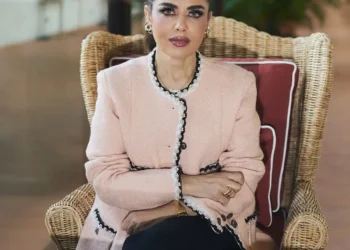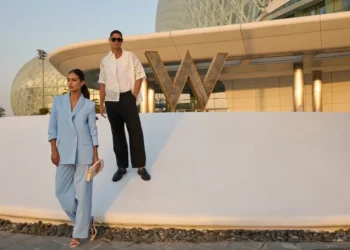A. LANGE & SÖHNE IS RENOWNED FOR ITS ‘ZERO-DEFECT’ MANUFACTURING APPROACH. HOW DO YOU INSTILL THIS CULTURE OF PERFECTION ACROSS YOUR TEAM, AND WHAT METRICS DO YOU USE TO MEASURE IT?
You know, normally human beings make mistakes, we all know that. But we don’t want to move away from hand craftsmanship because it’s something fascinating for us and for our clients. That’s why we invest a lot of time in checks and self-control systems. To achieve this level of perfection, around 95% of our movement production is done in-house. That’s why we have our own in-house movement production, covering almost all components. We only purchase certain things, like rubies, some screws, and the mainspring. But even the hairspring, we can make it in-house. We do this to ensure the quality level we want. Of course, sometimes you think, “Why not go to a specialist who might make some components even better?” But consider this: we only produce about 4,800 watches a year – sometimes 5,000. Last year it was 5,500 but it depends on the complexity of the collection. These days, complexity is increasing because of the new timepieces we’re introducing. We have limited capacity. There’s no large market for watchmakers, so we’ve had our own watchmaking school since 1997. Every year, around 16 young people graduate. That’s our limit. We can only produce as many watches as our capacity allows. And we’re talking about 27 different calibers. The simplest one has 167 components, while the most complicated one, the miniature repeater, has 771. You can imagine how complex the process is and how small the lot sizes are. So, if you call a supplier and say, “I need 25 prototypes,” he might say, “No, that’s already your whole year’s production!” That’s why we have such deep industrial integration. It allows us to control quality from the first step, which is parts production, through to finishing, where everything is polished, and finally to the last stages of assembly.
YOUR MOVEMENTS COMBINE CENTURIES-OLD TECHNIQUES WITH CUTTING-EDGE TECHNOLOGY. CAN YOU SHARE AN EXAMPLE WHERE MODERN MANUFACTURING SOLUTIONS ENHANCED-RATHER THAN COMPROMISED- TRADITIONAL CRAFTSMANSHIP?
A beautiful example is how we manage the complexity I just described. We need to be very flexible with our manufacturing technologies, so we combine milling and electro-erosion. This allows us to program machines for very small lot sizes. Electro-erosion lets us pass several times over one component to create a beautifully smooth surface. Then, our finishing team only needs to do the final touch without modifying the geometry because that would affect functionality. So, this combination of traditional handwork and cutting-edge tech works very well for us.
With over 600 components in some watches, how do you maintain consistency when training master watchmakers? What qualities do you look for in new artisans joining Lange’s workshops?
We’re happy to take skilled watchmakers from outside, but mostly we have to train our own people. We need to create our future. We need people who can sit at a table for eight hours, focused and concentrated. Some people are full of energy. They can’t sit still for more than five minutes. Even if they’re talented, if they’re not patient, it doesn’t work. We also need people with technical understanding. Not everyone can interpret drawings or visualize things in three dimensions. That limits how many people are suitable for this field. The apprenticeship takes three years. And even then, some students, after one or two years, might think they’re not talented enough for this and that’s okay.
GIVEN THE BRAND’S RELIANCE ON SPECIALIZED SUPPLIERS (E.G., GERMAN SILVER), HOW HAVE YOU ADAPTED YOUR SUPPLY CHAIN STRATEGY TO GLOBAL DISRUPTIONS WHILE PRESERVING QUALITY?
We have close collaborations with universities, research institutes, and a small company nearby, just 30 or 35 kilometers from us. It’s very important to have control over critical materials like German silver. Some components are tiny, like a spring that’s just 0.06 mm. If there’s any inconsistency or inhomogeneity in the material, the spring won’t function properly. Surface quality is also critical. If levers and other moving parts interact without a perfect surface, they absorb too much energy, which affects things like power reserve and amplitude. It’s really a very complex matter.
THE THREE-QUARTER PLATE IS A SIGNATURE OF LANGE MOVEMENTS BUT NOTORIOUSLY DIFFICULT TO FINISH FLAWLESSLY. HOW HAS YOUR TEAM INNOVATED TO MASTER THIS COMPONENT AT SCALE?
It’s true. With multiple bridges, you can insert wheels individually. But with the three-quarter plate, everything must align perfectly on a single axis. It’s a lot harder. The answer is simple: training, training, and more training. Watchmaking, in my opinion, is an experience-based profession. That’s why our watchmakers start young in our school, at 14 or 15 years old, and stay with us for decades. Now we have people who are only 30 or 35 years old but have already been with us for 20 years. They’ve gained incredible experience and are now working in our complications department. That’s how you get true master watchmakers.
LANGE’S WATCHES ARE BUILT TO LAST GENERATIONS. HOW DOES YOUR MANUFACTURING PROCESS REFLECT SUSTAINABLE PRINCIPLES, FROM MATERIAL SOURCING TO ENERGY USE?
Sustainability begins with the design process. Our movement designers must ensure that even 50 years from now, a well-trained watchmaker will be able to service the watch by disassembling, cleaning, oiling, and reassembling it. That’s a core principle. We also invest in our own training programs to build the future of watchmaking. And from an environmental standpoint, we learned that we have the largest geothermal system in Saxony. We didn’t even know it until a delegation from the UAE visited and the Saxon government asked us to host them. So yes, we are actively using sustainable energy.
YOU’RE KNOWN TO OCCASIONALLY WORK AT THE BENCH ALONGSIDE YOUR TEAM. WHY IS THIS HANDS-ON LEADERSHIP IMPORTANT, AND WHAT HAVE YOU LEARNED FROM IT RECENTLY?
These beautiful timepieces aren’t created by one person. It’s always a team effort. As Manufacturing Director, my role is to orchestrate the whole process over the 14 months it takes to build a watch. You have to be more than just technically capable. You must inspire people with passion. Assembly can be tough. You assemble, then realize something’s off, so you disassemble, adjust, and assemble again. It takes motivation and pride to do that over and over. That’s why we make sure every new hire spends a full day, or even two, touring the manufacture. They attend presentations, including one from me, where I talk about our history and our obsession with quality. We want them to understand why we do what we do.
AS GLASHÜTTE’S ONLY MANUFACTURER PRODUCING ALL MOVEMENT PARTS IN-HOUSE, WHAT TECHNOLOGICAL ADVANCEMENTS DO YOU FORESEE REVOLUTIONIZING LANGE’S PRODUCTION IN THE NEXT DECADE?
We currently use a combination of milling and wire-cutting electro-erosion. It’s a slow but incredibly precise method. Laser cutting would be faster, but right now, the surface finish from lasers isn’t good enough. The angles can also be slightly off. So, for now, we don’t use laser cutting in our production. We do use lasers in after-sales service. For example, to repair a deep scratch in a gold case without removing material. We fill the scratch with new gold and polish it. This helps preserve the integrity of the watch. But perhaps in the future, laser technology will improve enough to match the precision we need. If it does, it could make our processes faster and more efficient.

































